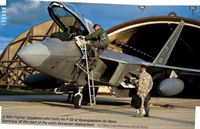Фотографии
-
The USAF’s F-22 Raptor was the progenitor of western fifth-generation stealth designs, although upgrades are required to keep it relevant as it continues through the second half of its expected service life
Самолёты на фотографии: Lockheed F-22 Raptor - США - 1990
-
A pair of F-22A Raptors from the 15th/154th Wing at Joint Base Pearl Harbor-Hickam, Hawaii, fly in formation over the clouds. This latest round of upgrades aims to equip the USAF’s 185-strong Raptor fleet with the Thales-developed Scorpion HMCS and an IRST sensor
Самолёты на фотографии: Lockheed F-22 Raptor - США - 1990
-
The USAF claims that “task saturation” poses a substantial threat to F-22A Raptor pilots, especially when operating in highly contested environments. These upgrades will seek to reduce pilot workload, freeing the pilot up to focus less on flying the aircraft and more on the mission at hand
Самолёты на фотографии: Lockheed F-22 Raptor - США - 1990
-
An F-22A Raptor from the 1st Fighter Wing at Joint Base Langley-Eustis, Virginia, pulls away from a Boeing KC-135 Stratotanker after refuelling on July 10, 2012
Самолёты на фотографии: Lockheed F-22 Raptor - США - 1990
-
The USAF demonstrated the MUM-T data-sharing capabilities of its gatewayONE payload during a series of test flights that culminated on December 9, 2020. On that day, a USAF-operated F-22A Raptor and F-35A Lightning II flew in formation with a Kratos Defense XQ-58A Valkyrie unmanned combat air vehicle (UCAV) from the Air Force Research Laboratory for the first time
Самолёты на фотографии: Kratos XQ-58 Valkyrie - США - 2019Lockheed F-22 Raptor - США - 1990Lockheed F-35A Lightning II - США - 2006
-
By creating a predictive maintenance capability to the Raptor fleet, the USAF could mitigate unscheduled equipment downtime and failures, and better maintain the overall reliability and availability of the type
Самолёты на фотографии: Lockheed F-22 Raptor - США - 1990
-
A 95th Fighter Squadron pilot exits his F-22 at Spangdahlem Air Base, Germany, at the start of the unit’s European deployment.
With this latest round of upgrades, the USAF also seeks to enhance the Raptor's situational awareness capabilities, while reducing pilot workload and amplifying their decision-making skillsСамолёты на фотографии: Lockheed F-22 Raptor - США - 1990
Статьи
- Focus: UAV, Rotary, Business, Technology, Space
- News: Commercial, Military
- A.Drwiega - Economies of scale
- A.Mladenov - Bear necessities
- J.Valero - Will they, won't they?
- J.Winchester - Hail to the King
- K.Chapman - Raptor regen
- M.Broadbent - Fire flight
- P.Eden - The big bounce back
- S.Gourley - High Society
- T.Batchelor - On the right track
- T.Batchelor - Planet-friendly flying






